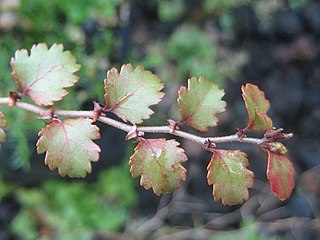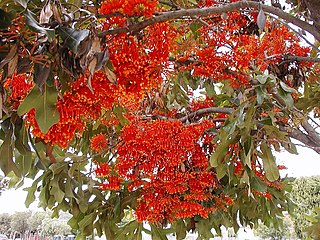
Araucaria is a genus of evergreen coniferous trees in the family Araucariaceae. There are 20 extant species in New Caledonia, Norfolk Island, eastern Australia, New Guinea, Papua (Indonesia), Argentina, Chile, Brazil, and Paraguay.

Nothofagus, also known as the southern beeches, is a genus of 43 species of trees and shrubs native to the Southern Hemisphere in southern South America and Australasia. The species are ecological dominants in many temperate forests in these regions. Some species are reportedly naturalised in Germany and Great Britain. The genus has a rich fossil record of leaves, cupules, and pollen, with fossils extending into the late Cretaceous period and occurring in Australia, New Zealand, Antarctica, and South America. In the past, they were included in the family Fagaceae, but genetic tests revealed them to be genetically distinct, and they are now included in their own family, the Nothofagaceae.

The Antarctic flora is a distinct community of vascular plants which evolved millions of years ago on the supercontinent of Gondwana. It is now found on several separate areas of the Southern Hemisphere, including southern South America, southernmost Africa, New Zealand, Australia and New Caledonia. Joseph Dalton Hooker was the first to notice similarities in the flora and speculated that Antarctica had served as either a source or a transitional point, and that land masses now separated might formerly have been adjacent.

Dicksonia is a genus of tree ferns in the order Cyatheales. It is regarded as related to Cyathea, but is considered to retain more primitive traits, dating back at least to the Jurassic and Cretaceous periods. The fossil record includes stems, pinnules, and spores.

The Atherospermataceae, commonly known as the southern sassafrases, are a family of broadleaf evergreen trees and shrubs. The family includes 14 species in seven genera. The atherosperms are today mostly distributed in the Southern Hemisphere, with two species native to southern Chile and 12 species native to Australasia. Wood is commercially harvested from rainforest species of this family, and is used both in construction and in fine cabinet making.

The Monimiaceae is a family of flowering plants in the magnoliid order Laurales. It is closely related to the families Hernandiaceae and Lauraceae. It consists of shrubs, small trees, and a few lianas of the tropics and subtropics, mostly in the southern hemisphere. The largest center of diversity is New Guinea, with about 75 species. Lesser centres of diversity are Madagascar, Australia, and the neotropics. Africa has one species, Xymalos monospora, as does Southern Chile. Several species are distributed through Malesia and the southwest Pacific.

Mekosuchus is a genus of extinct Australasian crocodiles within the subfamily Mekosuchinae. They are believed to have been made extinct by the arrival of humans on the South Pacific islands where they lived. The species of this genus were small in size, 2 m in maximum length, and terrestrial, making them the last surviving group of fully terrestrial crocodilians, leaving only semi-terrestrial species such as the Cuban crocodile and the dwarves Osteolaemus and Paleosuchus.

Siparunaceae is a family of flowering plants in the magnoliid order Laurales. It consists of two genera of woody plants, with essential oils: Glossocalyx in West Africa and Siparuna in the neotropics. Glossocalyx is monospecific and Siparuna has about 74 known species.

Stenocarpus is a genus of about 25 species of woody trees or shrubs, constituting part of the plant family Proteaceae.

Zieria is a genus of plants in the family, Rutaceae. About sixty species have been formally described, all of which are endemic to Australia except for one species which is found in New Caledonia. They occur in all Australian states except Western Australia but the genus is under review and a number of species are yet to be described or the description published. Zierias are similar to the better known genus Boronia but can be distinguished by the number of stamens in the flowers. The name Zieria honours the Polish botanist John Zier.

Kermadecia is a genus of flowering plants in the family Proteaceae. The genus comprises five species, all endemic to New Caledonia. Its closest relatives are Sleumerodendron and Turrillia, of which the species have once been placed in Kermadecia.

Laurelia is a genus of plant in the major group Angiosperms in the family Atherospermataceae, or formerly Monimiaceae. It contains only two species, both endemic to the southern hemisphere, an example of Gondwanan distribution.

Xanthostemon is a genus of trees and shrubs, constituting part of the myrtle plant family Myrtaceae. This genus was first described in 1857 by German–Australian botanist Ferdinand von Mueller. According to different official sources between 46 and 51 species are known to science. They grow naturally in New Caledonia, Australia, the Solomon Islands and Malesia, including the Philippines, New Guinea and Indonesia. The genera Pleurocalyptus and Purpureostemon from New Caledonia are morphologically close to Xanthostemon.

Parsonsia is a genus of woody vines in the family Apocynaceae. Species occur throughout Indomalaya, Australasia and Melanesia.

Atherosperma moschatum, the southern sassafras or blackheart sassafras, is an evergreen tree native to the cool temperate rainforests of Tasmania, Victoria, and New South Wales in Australia. It is common in the rainforests of Tasmania and Victoria, but more scattered and rare in the higher altitudes of eastern New South Wales. The northernmost area is at Mount Grundy, west of Port Macquarie.

Doryphora is a genus of plant in the family Atherospermataceae, or formerly Monimiaceae. It contains four species, two endemic to Australia.
Oncotheca is a genus of tree endemic to New Caledonia. There are two species, Oncotheca balansae and Oncotheca humboldtiana.

Stigmatodactylus is a genus of flowering plants from the orchid family, Orchidaceae. It has thirteen currently recognized species, native to China, Taiwan, Japan, the Himalayas, the Philippines, Malaysia, Indonesia, New Guinea and the Solomon Islands.
Flore de la Nouvelle-Calédonie is an ongoing multi-volume flora describing the vascular plants of New Caledonia in the South-West Pacific. published by the National Museum of Natural History in Paris since 1967. Each species treatment typically includes taxonomic information, morphological description, a line drawing and a distribution map. Originally published as Flore de la Nouvelle-Calédonie et Dépendances, since 2014 it has been renamed shortly Flore de la Nouvelle-Calédonie and is co-published with Institut de Recherche pour le Développement in a fully colored format. Flore de la Nouvelle-Calédonie currently consists of 27 volumes, covering little over 50% of a total of approximately 3,400 species native to the New Caledonian archipelago. Major botanical families awaiting treatment include Rubiaceae, Cyperaceae, Rutaceae, and Poaceae.

Don Foreman was an Australian botanist who worked on the Monimiaceae and Proteaceae of Australia. He also helped with the editing of selected Flora of Victoria and Flora of Australia Volumes.

















